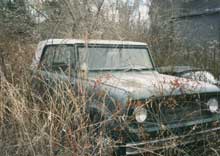Timing, as they say, is everything. International Harvester’s timing seemed ideal, when it introduced the new Scout utility vehicle as a ’61 model. Intended to challenge the Jeep CJ-5, it offered more modern styling and a dose of creature comforts. Power came from a “half-V8” slant four, derived from a truck engine. Scouts could be had as open vehicles, with a full top or as a half-roof pickup. Like Jeeps, they were useful for plowing snow and other country chores, especially with the larger cargo area. The Scout that heads this page is the fairly rare “Sportop“,” available as a convertible or with a fiberglass hardtop.
More than 28,000 Scouts were built in the model’s first year, nearly as many as Jeep built CJs. Demand held steady, with Scouts selling near 30,000 most years, despite competition from the Ford Bronco and Chevy Blazer and Jeep’s Scout-inspired Jeepster Commando. More powerful engines followed, a turbocharged four, a small V8 in 1967 and an AMC straight six in 1969, the year an automatic transmission became available. In 1971 came a longer-wheelbase Scout II (this is a ’73), which offered power steering and brakes and factory air. In addition to the standard Scout there was a hatchback Traveler, and a pickup called “Terra.” In 1976, a Nissan six-cylinder diesel joined the option list.
Scout sales rose to more than 40,000 in the late 1970s, and a replacement, to be called “Scout III,” got as far as the clay modeling stage. There was also a concept called SSV, for Scout Supplemental Vehicle. This was a smaller, lighter vehicle with a composite body. Often thought to be a Scout successor, it was actually a test bed for new materials. Only two were built, one of which is on display at the Auburn Cord Duesenberg Museum in Indiana.
As we know now, the future for SUVs was bright. The Bronco went on to beget the Explorer, midsize SUV market leader since its inception, out of the Bronco II. (How many Explorers can you see?) GM and Chrysler rushed to ready their own, Chrysler buying American Motors in 1987 on the strength of Jeep alone. What happened to Scout?
International Harvester had its own troubles. The popularity of well-equipped pickups from the Big Three led to the discontinuation of International’s light trucks in 1975. That left the Scout without any “supporting siblings,” and International’s dealer network was never very robust anyway. A lengthy strike starting in 1979 took its toll, also. A look at Jeep sales in the period shows that volume increased markedly after the American Motors takeover in 1970, partly, no doubt, because AMC had more dealers than previous owner Kaiser Jeep Corporation, and their dealers were more in touch with free-spending automotive consumers than budget-conscious truck customers. There was an attempt to set up an independent Scout Corporation in Texas, but this fell victim to financial difficulties of the principal players. What would have happened, though, if Chrysler had bought the Scout business in the early 1970s? Would all today’s Jeepers be Scout leaders instead?
With more than 530,000 built in 20 years, there are plenty of Scouts still around. Many of them in the northeast plow snow (and in Colorado, too). Old battered Scouts can be found as log skidders and general roustabout backwoods vehicles. Mudders like them, too. The last Scout was built on October 21,1980. It’s alive and well and living in Iowa. More about that soon.

